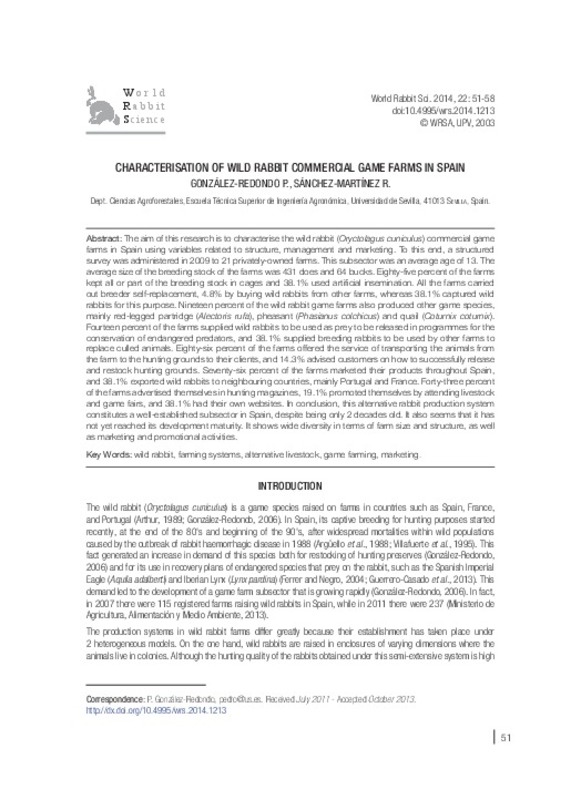JavaScript is disabled for your browser. Some features of this site may not work without it.
Buscar en RiuNet
Listar
Mi cuenta
Estadísticas
Ayuda RiuNet
Admin. UPV
Characterisation of wild rabbit commercial game farms in Spain
Mostrar el registro sencillo del ítem
Ficheros en el ítem
| dc.contributor.author | González-Redondo, Pedro
|
es_ES |
| dc.contributor.author | Sánchez-Martínez, Rosario
|
es_ES |
| dc.date.accessioned | 2014-07-29T09:03:50Z | |
| dc.date.available | 2014-07-29T09:03:50Z | |
| dc.date.issued | 2014-03-28 | |
| dc.identifier.issn | 1257-5011 | |
| dc.identifier.uri | http://hdl.handle.net/10251/39112 | |
| dc.description.abstract | [EN] The aim of this research is to characterise the wild rabbit (Oryctolagus cuniculus) commercial game farms in Spain using variables related to structure, management and marketing. To this end, a structured survey was administered in 2009 to 21 privately-owned farms. This subsector was an average age of 13. The average size of the breeding stock of the farms was 431 does and 64 bucks. Eighty-five percent of the farms kept all or part of the breeding stock in cages and 38.1% used artificial insemination. All the farms carried out breeder self-replacement, 4.8% by buying wild rabbits from other farms, whereas 38.1% captured wild rabbits for this purpose. Nineteen percent of the wild rabbit game farms also produced other game species, mainly red-legged partridge (Alectoris rufa), pheasant (Phasianus colchicus) and quail (Coturnix coturnix). Fourteen percent of the farms supplied wild rabbits to be used as prey to be released in programmes for the conservation of endangered predators, and 38.1% supplied breeding rabbits to be used by other farms to replace culled animals. Eighty-six percent of the farms offered the service of transporting the animals from the farm to the hunting grounds to their clients, and 14.3% advised customers on how to successfully release and restock hunting grounds. Seventy-six percent of the farms marketed their products throughout Spain, and 38.1% exported wild rabbits to neighbouring countries, mainly Portugal and France. Forty-three percent of the farms advertised themselves in hunting magazines, 19.1% promoted themselves by attending livestock and game fairs, and 38.1% had their own websites. In conclusion, this alternative rabbit production system constitutes a well-established subsector in Spain, despite being only 2 decades old. It also seems that it has not yet reached its development maturity. It shows wide diversity in terms of farm size and structure, as well as marketing and promotional activities. | es_ES |
| dc.language | Inglés | es_ES |
| dc.publisher | Editorial Universitat Politècnica de València | |
| dc.relation.ispartof | World Rabbit Science | |
| dc.rights | Reserva de todos los derechos | es_ES |
| dc.subject | Wild rabbit | es_ES |
| dc.subject | Farming systems | es_ES |
| dc.subject | Alternative livestock | es_ES |
| dc.subject | Game farming | es_ES |
| dc.subject | Marketing | es_ES |
| dc.title | Characterisation of wild rabbit commercial game farms in Spain | es_ES |
| dc.type | Artículo | es_ES |
| dc.date.updated | 2014-07-25T10:55:35Z | |
| dc.identifier.doi | 10.4995/wrs.2014.1213 | es_ES |
| dc.rights.accessRights | Abierto | es_ES |
| dc.description.bibliographicCitation | González-Redondo, P.; Sánchez-Martínez, R. (2014). Characterisation of wild rabbit commercial game farms in Spain. World Rabbit Science. 22(1):51-58. https://doi.org/10.4995/wrs.2014.1213 | es_ES |
| dc.description.accrualMethod | SWORD | es_ES |
| dc.relation.publisherversion | https://doi.org/10.4995/wrs.2014.1213 | es_ES |
| dc.description.upvformatpinicio | 51 | es_ES |
| dc.description.upvformatpfin | 58 | es_ES |
| dc.type.version | info:eu-repo/semantics/publishedVersion | es_ES |
| dc.description.volume | 22 | |
| dc.description.issue | 1 | |
| dc.identifier.eissn | 1989-8886 |








